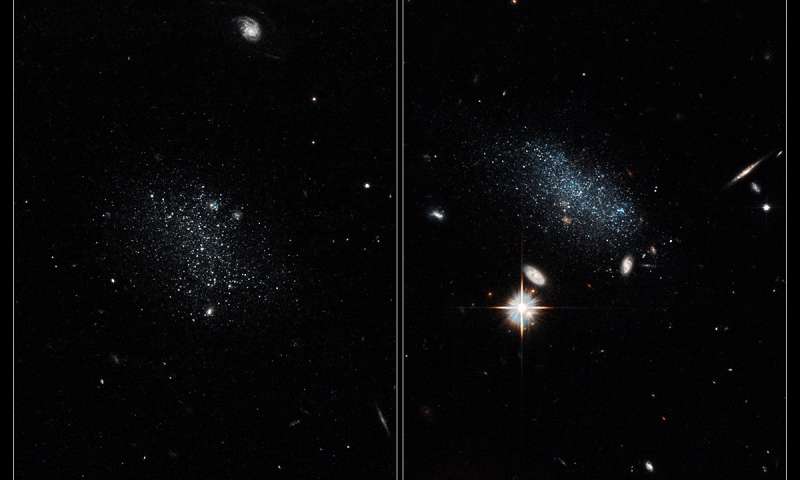
On the left is Pisces A, 19 million light-years away. On the right we can see Pisces B, which is around 30 million light-years way. Credit: NASA, ESA, and E. Tollerud (STScI)
Hubble just spotted two dwarf galaxies leave the galactic wilderness for a much more crowded region, drawn in by gravity. The pair previously inhabited a region of the Universe sparsely populated with galaxies, the 150 million light-years across Local Void. Astronomers say the galaxies are now ready to seriously nurse many new stars as they enter a more welcoming breeding ground rich in gas and dust.
“These Hubble images may be snapshots of what present-day dwarf galaxies may have been like at earlier epochs,” said lead researcher Erik Tollerud of the Space Telescope Science Institute in Baltimore, Maryland. “Studying these and other similar galaxies can provide further clues to dwarf galaxy formation and evolution.”
A dwarf galaxy is a small galaxy composed of about 100 million up to several billion stars. Though impressive, it’s still a trifle even when compared to a medium-sized galaxy like the Milky Way which hosts 200–400 billion stars. But dwarf galaxies, which are extremely faint and hard to detect, are extremely interesting for astronomers.
First of all, they’re the most numerous kind of galaxies in the universe. Secondly, dwarfs are the Milky Way’s closest neighbours allowing high-quality data to be gathered by telescopes. Dwarfs were also the building blocks of larger galaxies which formed billions of years ago — after all, everything started out small. We owe a lot of what we know about how galaxies form to dwarfs.
These recent dwarfs spotted by the Hubble Telescope, Pisces A and B, each contain only about 10 million stars — very sparsely populated even by galactic dwarven standards.
“These galaxies may have spent most of their history in the void,” Tollerud explained. “If this is true, the void environment would have slowed their evolution. Evidence for the galaxies’ void address is that their hydrogen content is somewhat high relative to similar galaxies. In the past, galaxies contained higher concentrations of hydrogen, the fuel needed to make stars. But these galaxies seem to retain that more primitive composition, rather than the enriched composition of contemporary galaxies, due to a less vigorous history of star formation. The galaxies also are quite compact relative to the typical star-forming galaxies in our galactic neighborhood.”
Astronomers found the dwarf pair while surveying hydrogen content in the Milky Way using radio telescopes. Thousands of small blobs packed with dense hydrogen gas were discovered within our galaxy, but some 30 to 50 of these blobs seemed to be located outside of it. Tollerud and colleagues then selected a couple which seemed like worthy candidates for nearby galaxies and asked permission to use Hubble’s Advanced Camera for Surveys to analyse them.
For this purpose, Hubble is particularly well-suited thanks to its sharp vision which can resolve individual stars and reliably estimate a galaxy’s distance. The distance is particularly important for determining brightness, as well as for calculating how far a galaxy is from a void.
The scientists found Pisces A is 19 million light-years away from Earth while Pisces B is roughly 30 million light-years away. Each galaxy has 20 to 30 bright blue stars, signifying they’re still very young — less than 100 million years old. At some point, the galaxies doubled their star formation rate as they closed in a more crowded sector. This star formation rate may slow down if the dwarfs draw too near a much larger galaxy and become satellites.
“The galaxies could even probably stop forming stars altogether, because they will stop getting new gas to make stars,” Tollerud said. “So they will use up their existing gas. But it’s hard to tell right now exactly when that would happen, so it’s a reasonable guess that the star formation will ramp up at least for a while.”
Findings appeared in the Astrophysical Journal.









